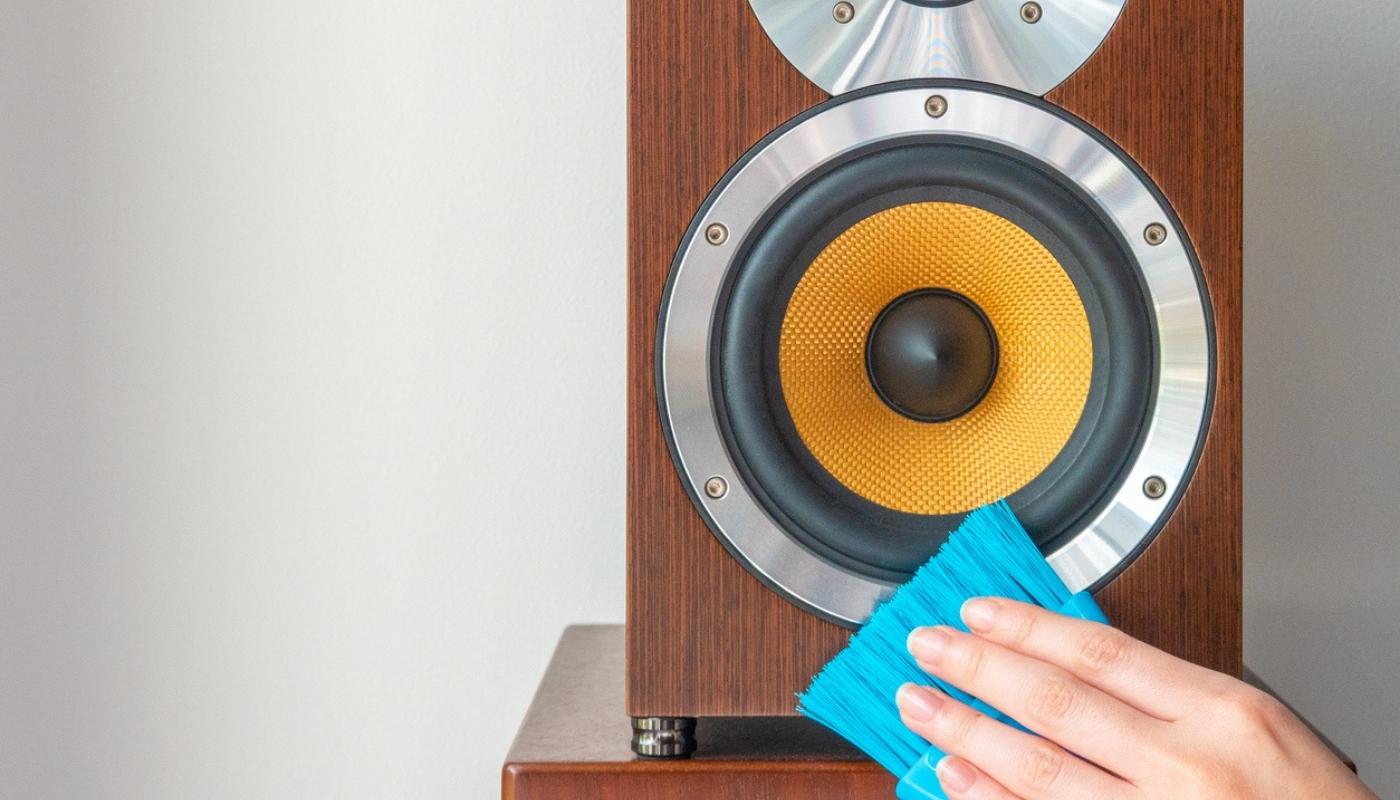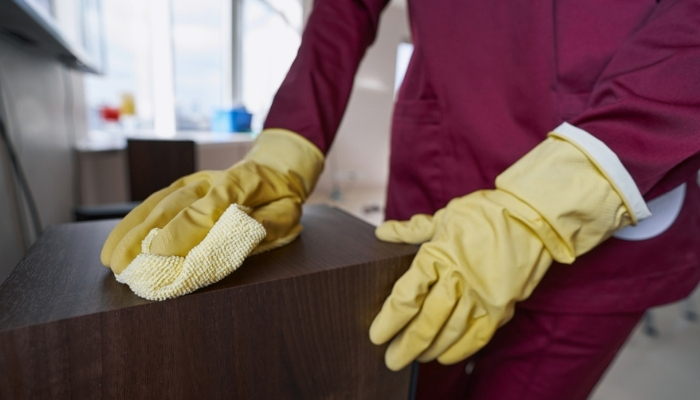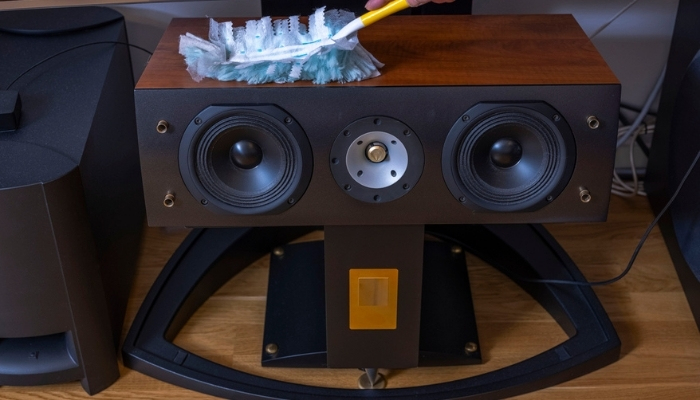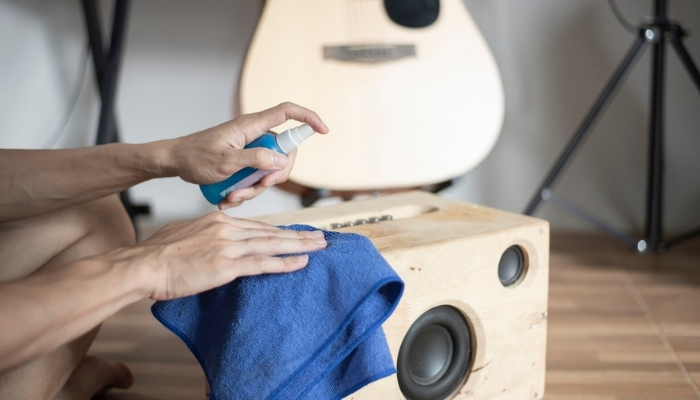When you find a set of home audio speakers you like, there's no reason you can't enjoy them for a very long time. Although speakers require relatively little maintenance, you should still give them some basic upkeep, starting with cleaning.
It's important to keep in mind that you don't want to cause more harm than good when cleaning your speakers. Because of this, it's a good idea to steer clear of harsh chemicals or too much moisture, and overall be gentle. Here is a simple guide to the right steps, supplies, and cleaners to clean your speakers properly.

Materials for Cleaning Speakers
Luckily to clean speakers, you don’t need any high-tech equipment. In fact, most of the supplies you already have on hand.
To clean your speakers, you’ll need:
- A dust cloth or a soft-bristled brush
- A vacuum cleaner with a soft brush attachment
- A mild soap (optional)
- Clean water
-Compressed air
- A lint-free cloth, soft cotton towel, or paper towel
How to Clean the Speaker Cabinet
Regardless of the type or size of the speaker, find out what the cabinets are constructed of before you begin cleaning. A variety of woods, including cherry, walnut, maple, oak, and pine, are used to make speaker cabinets. The cabinet might even be painted or stained wood, allowing it to exhibit its natural look. Alternatively, it could be coated with wax, polyurethane, varnish, or lacquer, which tend to have a glossy or satiny shine. Knowing the exterior will enable you to select the ideal cleaning and finishing products. The type of wood also matters if a cleaner or oil is for a specific material.
Start by removing any dirt and dust from the cabinet. Use a dust cloth or soft-bristled brush to gently remove debris from the speaker's surface. You can also use a vacuum cleaner with a soft brush attachment to help remove any stubborn dirt. If needed, you can dampen a cloth with clean water with mild soap to remove any tough stains. Be sure to avoid using harsh chemicals or abrasive cleaners, as these can damage the speaker’s finish. Once you’ve removed all the dirt and dust, dry the cabinet with a lint-free cloth or paper towel. Apply an oil or varnish protective layer when you're done cleaning if needed and use a separate clean cloth and follow the product’s instructions.

How to Clean the Speaker Grill
Speaker grills are often a delicate fabric, similar to stockings and pantyhose. Therefore, use caution when handling and cleaning grills, particularly if you don't know how they're fastened or if they aren't removable. Metal grills on some speakers may be waffle-, checkerboard-, or dot-patterned. Additionally, fabric grills can be fastened to frames, most of which can be removed with a light tug. Consult the user handbook for the product if you're unsure how to remove the grill.
The grill is responsible for protecting the speaker cone from debris, so it’s important to keep it clean. Once you remove the grill, use a soft-bristled brush or a vacuum cleaner with a soft brush attachment to remove any dirt and dust from the surface of the grill. If needed, you can dampen your cloth with clean water and a mild soap to remove any tough stains. Once you’ve removed all the dirt and dust, dry the grill with a lint-free cloth or soft cotton towel and place it back on the speaker.
On the other hand, sometimes grills aren't made to be removed. If the fabric grills on your speaker won't come off, use a lint roller, vacuum, or a can of compressed air to clean the material. The vacuum cleaner and compressed air should remove any loose dust and grime from non-removable metal or plastic grills. Use a moist towel sparingly and dry completely if you need to wipe the grill surfaces.
How to Clean the Speaker Cones
The speaker cone is responsible for producing sound, so it’s important to take care when cleaning it. Speaker cones are very delicate and easy to break with little effort. If you have metal, wood, kevlar, or polymer cones, they are more durable, but the wrong move can damage the sensitive drivers positioned behind the cones.
When cleaning, use a soft-bristled brush or a vacuum cleaner with a soft brush attachment to remove any dirt and dust from the surface of the speaker cone. If needed, you can dampen your cloth with clean water and mild soap to remove any tough stains. Once you’ve removed all the dirt and dust, dry the speaker cone with a lint-free cloth or paper towel.

How to Clean the Speaker Terminals
The speaker terminals are responsible for connecting your speakers to your audio system, so keeping them clean is important. Use a soft-bristled brush or a vacuum cleaner with a soft brush attachment to remove any dirt and dust from the connections and seams. If needed, use a clean q-tip to clean the finer debris that collects in and around the spring clips, binding posts, small spaces, crevices, and divots. Never use water or any water-based cleaning solutions with speaker terminals, isopropyl alcohol (99%) is a safer choice to wipe them down. Once you’ve removed all the dirt and dust, dry the terminals the reconnect the parts.

By following these simple tips, you can keep your speakers looking and sounding great for years to come! But, if cleaning your speakers opens your eyes to internal damage, don’t fret Toton’s TV is here. We have the perfect speaker for your home audio upgrade! And if you have any questions while shopping, just give us a call; we’re happy to help!